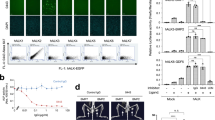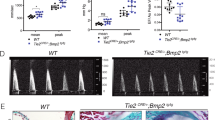Abstract
Fibrodysplasia ossificans progressiva (FOP) is a congenital disorder of progressive and widespread postnatal ossification of soft tissues1,2,3,4 and is without known effective treatments. Affected individuals harbor conserved mutations in the ACVR1 gene that are thought to cause constitutive activation of the bone morphogenetic protein (BMP) type I receptor, activin receptor-like kinase-2 (ALK2)5. Here we show that intramuscular expression in the mouse of an inducible transgene encoding constitutively active ALK2 (caALK2), resulting from a glutamine to aspartic acid change at amino acid position 207, leads to ectopic endochondral bone formation, joint fusion and functional impairment, thus phenocopying key aspects of human FOP. A selective inhibitor of BMP type I receptor kinases, LDN-193189 (ref. 6), inhibits activation of the BMP signaling effectors SMAD1, SMAD5 and SMAD8 in tissues expressing caALK2 induced by adenovirus specifying Cre (Ad.Cre). This treatment resulted in a reduction in ectopic ossification and functional impairment. In contrast to localized induction of caALK2 by Ad.Cre (which entails inflammation), global postnatal expression of caALK2 (induced without the use of Ad.Cre and thus without inflammation) does not lead to ectopic ossification. However, if in this context an inflammatory stimulus was provided with a control adenovirus, ectopic bone formation was induced. Like LDN-193189, corticosteroid inhibits ossification in Ad.Cre-injected mutant mice, suggesting caALK2 expression and an inflammatory milieu are both required for the development of ectopic ossification in this model. These results support the role of dysregulated ALK2 kinase activity in the pathogenesis of FOP and suggest that small molecule inhibition of BMP type I receptor activity may be useful in treating FOP and heterotopic ossification syndromes associated with excessive BMP signaling.
This is a preview of subscription content, access via your institution
Access options
Subscribe to this journal
Receive 12 print issues and online access
$209.00 per year
only $17.42 per issue
Buy this article
- Purchase on Springer Link
- Instant access to full article PDF
Prices may be subject to local taxes which are calculated during checkout




Similar content being viewed by others
Change history
04 December 2008
In the version of this article initially published, the title included a misspelling—‘heterotropic’ should have been ‘heterotopic’. Additionally, the fourth and fifth sentences of the abstract were incorrectly worded and have been corrected to state more clearly the role of Ad.Cre. These changes do not affect the scientific content of the text. The errors have been corrected in the HTML and PDF versions of the article.
References
Shore, E.M. & Kaplan, F.S. Insights from a rare genetic disorder of extra-skeletal bone formation, fibrodysplasia ossificans progressiva (FOP). Bone 43, 427–433 (2008).
Buyse, G., Silberstein, J., Goemans, N. & Casaer, P. Fibrodysplasia ossificans progressiva: still turning into wood after 300 years? Eur. J. Pediatr. 154, 694–699 (1995).
Kaplan, F.S., Glaser, D.L., Pignolo, R.J. & Shore, E.M. A new era for fibrodysplasia ossificans progressiva: a druggable target for the second skeleton. Expert Opin. Biol. Ther. 7, 705–712 (2007).
Kaplan, F.S. et al. Fibrodysplasia ossificans progressiva. Best Pract. Res. Clin. Rheumatol. 22, 191–205 (2008).
Shore, E.M. et al. A recurrent mutation in the BMP type I receptor ACVR1 causes inherited and sporadic fibrodysplasia ossificans progressiva. Nat. Genet. 38, 525–527 (2006).
Cuny, G.D. et al. Structure-activity relationship study of bone morphogenetic protein (BMP) signaling inhibitors. Bioorg. Med. Chem. Lett. 18, 4388–4392 (2008).
Tsuchida, K., Mathews, L.S. & Vale, W.W. Cloning and characterization of a transmembrane serine kinase that acts as an activin type I receptor. Proc. Natl. Acad. Sci. USA 90, 11242–11246 (1993).
Miyazono, K., Maeda, S. & Imamura, T. BMP receptor signaling: Transcriptional targets, regulation of signals, and signaling cross-talk. Cytokine Growth Factor Rev. 16, 251–263 (2005).
Groppe, J.C., Shore, E.M. & Kaplan, F.S. Functional modeling of the ACVR1 (R206H) mutation in FOP. Clin. Orthop. Relat. Res. 462, 87–92 (2007).
Shore, E.M., Xu, M., Connor, J.M. & Kaplan, F.S. Mutations in the BMP type I receptor ACVR1 in patients with fibrodysplasia ossificans progressiva (FOP). J. Bone Miner. Res. 21, S75 (2006).
Macias-Silva, M., Hoodless, P.A., Tang, S.J., Buchwald, M. & Wrana, J.L. Specific activation of Smad1 signaling pathways by the BMP7 type I receptor, ALK2. J. Biol. Chem. 273, 25628–25636 (1998).
Zhang, D. et al. ALK2 functions as a BMP type I receptor and induces Indian hedgehog in chondrocytes during skeletal development. J. Bone Miner. Res. 18, 1593–1604 (2003).
Koefoed, M. et al. Biological effects of rAAV-caAlk2 coating on structural allograft healing. Mol. Ther. 12, 212–218 (2005).
Fukuda, T. et al. Generation of a mouse with conditionally activated signaling through the BMP receptor, ALK2. Genesis 44, 159–167 (2006).
Waheed, I. et al. Factors associated with induced chronic inflammation in mdx skeletal muscle cause posttranslational stabilization and augmentation of extrasynaptic sarcolemmal utrophin. Hum. Gene Ther. 16, 489–501 (2005).
Yu, P.B. et al. Dorsomorphin inhibits BMP signals required for embryogenesis and iron metabolism. Nat. Chem. Biol. 4, 33–41 (2008).
Yu, P.B. et al. Bone morphogenetic protein (BMP) type II receptor is required for BMP-mediated growth arrest and differentiation in pulmonary artery smooth muscle cells. J. Biol. Chem. 283, 3877–3888 (2008).
Billings, P.C. et al. Dysregulated BMP signaling and enhanced osteogenic differentiation of connective tissue progenitor cells from patients with fibrodysplasia ossificans progressiva (FOP). J. Bone Miner. Res. 23, 305–313 (2008).
Fukuda, T. et al. Constitutively activated ALK2 and increased smad1/5 cooperatively induce BMP signaling in fibrodysplasia ossificans progressiva. J. Biol. Chem. published online, doi: 10.1074/jbc.M801681200 (6 August 2008).
Hegyi, L. et al. Stromal cells of fibrodysplasia ossificans progressiva lesions express smooth muscle lineage markers and the osteogenic transcription factor Runx2/Cbfa-1: clues to a vascular origin of heterotopic ossification? J. Pathol. 201, 141–148 (2003).
Hayashi, S. & McMahon, A.P. Efficient recombination in diverse tissues by a tamoxifen-inducible form of Cre: a tool for temporally regulated gene activation/inactivation in the mouse. Dev. Biol. 244, 305–318 (2002).
Scarlett, R.F. et al. Influenza-like viral illnesses and flare-ups of fibrodysplasia ossificans progressiva. Clin. Orthop. Relat. Res. 275–279 (2004).
Kaplan, F.S. et al. Hematopoietic stem-cell contribution to ectopic skeletogenesis. J. Bone Joint Surg. Am. 89, 347–357 (2007).
Pignolo, R.J., Suda, R.K. & Kaplan, F.S. The fibrodysplasia ossificans progressiva lesion. Clin. Rev. Bone Miner. Metab. 5, 195–200 (2005).
Zhao, G.Q. Consequences of knocking out BMP signaling in the mouse. Genesis 35, 43–56 (2003).
Tsuji, K. et al. BMP2 activity, although dispensable for bone formation, is required for the initiation of fracture healing. Nat. Genet. 38, 1424–1429 (2006).
Corriere, M.A. et al. Endothelial Bmp4 is induced during arterial remodeling: effects on smooth muscle cell migration and proliferation. J. Surg. Res. 145, 142–149 (2008).
Yu, P.B., Beppu, H., Kawai, N., Li, E. & Bloch, K.D. Bone morphogenetic protein (BMP) type II receptor deletion reveals BMP ligand–specific gain of signaling in pulmonary artery smooth muscle cells. J. Biol. Chem. 280, 24443–24450 (2005).
Komori, T. et al. Targeted disruption of Cbfa1 results in a complete lack of bone formation owing to maturational arrest of osteoblasts. Cell 89, 755–764 (1997).
Korchynskyi, O. & ten Dijke, P. Identification and functional characterization of distinct critically important bone morphogenetic protein–specific response elements in the Id1 promoter. J. Biol. Chem. 277, 4883–4891 (2002).
Fujii, M. et al. Roles of bone morphogenetic protein type I receptors and Smad proteins in osteoblast and chondroblast differentiation. Mol. Biol. Cell 10, 3801–3813 (1999).
Dennler, S. et al. Direct binding of Smad3 and Smad4 to critical TGF β–inducible elements in the promoter of human plasminogen activator inhibitor-type 1 gene. EMBO J. 17, 3091–3100 (1998).
Shimizu, A. et al. Identification of receptors and Smad proteins involved in activin signalling in a human epidermal keratinocyte cell line. Genes Cells 3, 125–134 (1998).
Acknowledgements
We thank P. ten Dijke (Leiden University Medical Center) for providing BRE-Luc and CAGA-Luc and K. Miyazono (University of Tokyo) for providing caALK2, caALK3, caALK4, caALK5, caALK6 and caALK7. We are grateful to H. Beppu, E. Schipani, H. Kronenberg, A. Wagers, J. Groppe, W. Zapol and F. Kaplan for insightful discussions and technical expertise, A. Graveline and D. Panus for technical assistance and E. Buys for technical expertise. This work was supported by US National Institutes of Health grants HL079943 (P.B.Y.) and HL074352 (K.D.B.), the US National Institute of Environmental Health Sciences Intramural Research Program grant ES071003-10 (Y.M.) and Partners Healthcare. This work was also supported by a Howard Hughes Medical Institute Early Career Award (P.B.Y.), a Pulmonary Hypertension Association Mentored Clinical Scientist Award (P.B.Y.), a grant from the GlaxoSmithKline Research & Education Foundation for Cardiovascular Disease (P.B.Y.) and a Developmental Grant from the Center for Research in Fibrodysplasia Ossificans Progressiva and Related Disorders at the University of Pennsylvania (C.C.H.).
Author information
Authors and Affiliations
Contributions
P.B.Y. wrote the manuscript. P.B.Y., D.Y.D. and C.S.L. designed and performed experiments and analyzed data. G.D.C., P.B.Y., K.D.B. and R.T.P. helped to design, synthesize and evaluate dorsomorphin derivatives, and G.D.C. provided pharmacokinetic data. M.L.B. provided technical expertise and μCT tomography data. D.W.H. and P.M.M. performed experiments. C.S. tested the efficacy of the dorsomorphin derivative with additional assays. N.K. performed control experiments. Y.M. and T.F. provided key experimental reagents. T.K. provided reagents and experimental advice. C.C.H., Y.M. and K.D.B. provided feedback and experimental advice, and P.B.Y. and K.D.B. edited the manuscript.
Supplementary information
Supplementary Text and Figures
Supplementary Figs. 1–7 (PDF 603 kb)
Supplementary Video 1
A wild-type mouse injected with Ad.Cre in the left hindlimb (P7), shown at P60. No deficits in limb function or gait are apparent. (MOV 1633 kb)
Supplementary Video 2
A conditional caALK2 mouse injected with Ad.Cre in the left hindlimb (P7), shown at P60. Severe fixed extension of the left hindlimb prevents use of the limb during ambulation. (MOV 3987 kb)
Supplementary Video 3
Vehicle-treated, Ad.Cre-injected conditional caALK2 mouse shown at P15. Mild impairment of gait due to decreased range-of-motion of the knee and hip joints. (MOV 2955 kb)
Supplementary Video 4
Vehicle-treated, Ad.Cre-injected conditional caALK2 mouse shown at P30. Severe gait impairment due to fixed extension of knee, hip and ankle joints. (MOV 1338 kb)
Supplementary Video 5
LDN-193189-treated, Ad.Cre-injected conditional caALK2 mouse shown at P15. No impairment of gait or range-of-motion. (MOV 2631 kb)
Supplementary Video 6
LDN-193189-treated, Ad.Cre-injected conditional caALK2 mouse shown at P30. Mild gait abnormality due to moderately decreased range of motion in knee and hip joints. (MOV 3027 kb)
Rights and permissions
About this article
Cite this article
Yu, P., Deng, D., Lai, C. et al. BMP type I receptor inhibition reduces heterotopic ossification. Nat Med 14, 1363–1369 (2008). https://doi.org/10.1038/nm.1888
Received:
Accepted:
Published:
Issue Date:
DOI: https://doi.org/10.1038/nm.1888
This article is cited by
-
Impaired bone morphogenetic protein (BMP) signaling pathways disrupt decidualization in endometriosis
Communications Biology (2024)
-
The roles and regulatory mechanisms of TGF-β and BMP signaling in bone and cartilage development, homeostasis and disease
Cell Research (2024)
-
Context-dependent TGFβ family signalling in cell fate regulation
Nature Reviews Molecular Cell Biology (2023)
-
Protocol paper: a multi-center, double-blinded, randomized, 6-month, placebo-controlled study followed by 12-month open label extension to evaluate the safety and efficacy of Saracatinib in Fibrodysplasia Ossificans Progressiva (STOPFOP)
BMC Musculoskeletal Disorders (2022)
-
Exploration of marine natural resources in Indonesia and development of efficient strategies for the production of microbial halogenated metabolites
Journal of Natural Medicines (2022)



